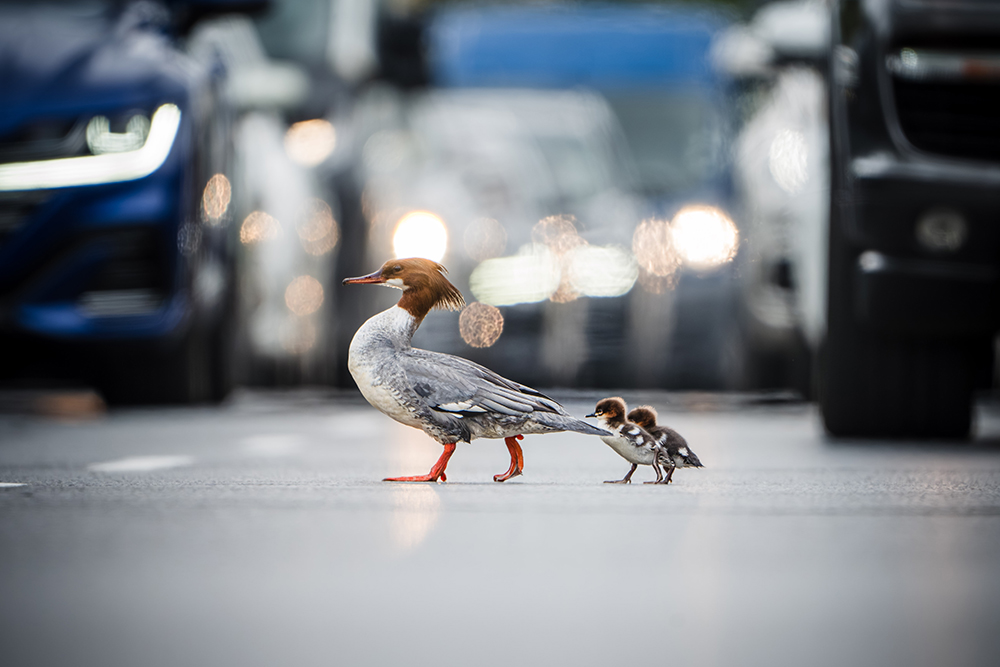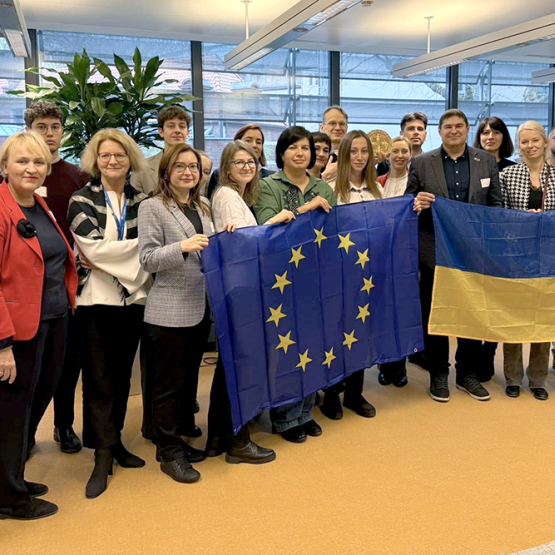An interview with Aleksander Jura, a graduate of the SGH Warsaw School of Economics and the winner of the first prize for the photo “School Bus” in the category of Ecology and Climate Change at the 20th Great Photo Competition of the magazine National Geographic Polska.
Anna Sydorczak: After studying quantitative methods in economics and information systems, you became a photographer. What inspired you to start this adventure and how has your passion developed over the years?
Aleksander Jura: I have always been interested in photography, even before I started studying at university. I take photos mainly for myself, it’s my hobby. I’ve always been an ambitious person and I’ve always wanted to be the best at what I do. Photography is a passion in which I can combine all my other passions. A few months before coming to university, I started to pay more attention to photography, which with the passage of time and the development of skills turned into paid work. At this point, I make a living from photography.

The awarded photo “School bus”. Mergansers leading their young across Wisłostrada. Warsaw 2024
You have recently won a National Geographic Polska competition, which was a kind of seal on what you do. Tell our readers how this winning photo was created as the frame shows us a fairly non-standard shot.
I’ve been thinking about shooting wildlife for a long time, but first I had to save up money for a better lens. It took me a while and by the end of 2023 I could afford this sort of purchase. I’d already had some experience in photography, I was doing quite well achieving my first successes. I’m open-minded, I like working with people, and it’s interesting because photographers are usually introverted and closed. And I really like working with both introverts and extroverts. I know that extroversion opens up introverts a bit and allows them to maintain such a nice balance, so I started to feel a little like a fish in water. In addition to other smaller projects I had, in the spring of 2024 I received information from a friend who works as a gardener in the Royal Łazienki Park and, like me, is a great enthusiast of photography, that the so-called merganser crossings are taking place in the area. In spring, the hatching season of these birds begins. They swim through all the canals from the Łazienki area to the Vistula. In order to prolong the species, mergansers have to cross two roads: Czerniakowska and Łazienkowska streets near the Legia stadium. I was really intrigued, I hadn’t come across this phenomenon before. Later, it turned out that it was a small Warsaw classic event. When you are driving along Czerniakowska Street, you can even notice special warning signs with symbolic drawings of mergansers. So I started my “hunt” for the right frame and before work, every second day, I came to the Łazienki area to look for the perfect one. I spent a lot of time following the scheme. One Sunday, I came into conclusion that I would not take pictures of mergansers, which were afraid of crowds and usually did not show up on the route. However, on that day, while browsing the Internet, I saw someone’s photos of the merganser crossing Czerniakowska Street. I was really disappointed. But I found out that there are several more such pairs of mergansers in Łazienki park. I spent the next mornings in the park, where I came every day and tried to capture the moment of the birds’ crossing. I also met people from the Greenery Board of the capital city of Warsaw, who are involved in the organisation of volunteering aimed at safely guiding mergansers across Wisłostrada. Being there again, one morning I noticed that a pair of mergansers were swimming in one of the ponds and I informed the volunteers about it. We walked with one of them along the aforementioned route. It took us about five hours and it is from this “trip” that my winning photo comes from. Later, I attended three other crossings, one of which lasted two days.
Where do your passion and love for photography come from?
The passion comes from the fact that it is a simple, pleasant, and at the same time satisfying type of art combined with physics and science. Photography has been something technical for me since the beginning. I was most interested in how light behaves, but also the camera itself as a research tool that collects measurements in the form of an image recorded on the matrix. You can just go outside, to some wild place and always have your camera with you, take a picture and then edit it at home, so it’s a very pleasant form of art. On the other hand, it is a fairly simple activity that does not require very much energy and time. I usually meet classical music or dance artists, theatre actors – they practice non-stop, sometimes even from the age of five, and devote time to being the best. And photography is very accessible today and does not require such sacrifices. The only “entry threshold” is the purchase of equipment and learning how to use it. In my opinion, every person who would like to learn photography is able to acquire this knowledge. However, it seems to me that in wildlife photography you have to be very well organised and plan the whole process of taking photos. For example, recently I took up photographing the sky. First, you have to choose the right days – the moon must be new. In Poland, the centre of the Milky Way is seen only in specific months and in a specific place, so the so-called lunar window appears first, then the Milky Way window. We may have a plan for the session and a set date when the sky is supposed to be cloudless, suddenly one small cloud may appear and spoil the whole project. I’ve been going to the Dolomites in December for 15 years and I have a habit of staying overnight on the slope just to take a photo of the sky at night. I’ve always had a lunar window for five years. But when the moon was new, I had only one cloudless night left to take such a photo.
Jacek Patrzykont, a legend of Polish climbing instructors at the top of the Enis rock. Rudawy 2024
You are self-taught in the field of photography. What were your biggest challenges during your studies and how did you face them?
To be honest, in the process of taking photos and developing them, I did not encounter any real problems. This is a process that I followed in harmony with myself, I also gave myself a lot of space for possible mistakes, I learned step by step. My intuition helped me most in this approach, as well as the people around me who evaluated my work and sometimes also criticised it. Thanks to their advice and comments, I developed my own style. As for the challenges, I think that the main problem, not only for me, but for most photographers, is the evaluation of their own work. No university will teach that, everyone has to approach it individually. This is probably the most stressful stage, when you are interested in the project itself, you already have an idea for it, and the client asks you how much it will cost. For me personally, this is the moment when I could answer that I will do it for free, but I can’t, because it is the source of my income. On the other hand, I don’t want to put the client off. Another problem is competition. There are many good photographers on the market, including professionals convinced of their uniqueness. And the truth is that there are no extraordinary people in photography. Because it’s so accessible now, and so many people, not only professionals, can capture truly unique moments, the field is becoming very common.
Let’s come back to your winning photo. You have already said that nature photography is your true passion. Why such a topic? How important is ecology or the environment to you?
Absolutely. It seems to me that many people now live in hypocrisy and because they do not have this contact with nature, they close themselves off in their views, for example, on climate change. Maybe if they started visiting new places, they would change their minds on this subject, they would get out of the so-called bambinism and see that it is not so beautiful and rosy, because the world is very brutal. I am convinced that contact with nature is beneficial for mental health. Of course, I won’t encourage everyone to give up psychologists and go to the forest (laughter), but in my opinion, communing with nature and “getting tired” in its surroundings allows you to take a mental break from the modern rush. Many friends of mine or people of my age struggle with depression. I myself often have worse moments, but going out of town and being physically tired in nature make me rest. Man has not changed for 10,000 years, evolution is slow, but civilisation has moved forward a lot. Being surrounded by nature can calm you down and your head returns to the state of balance.
Natalia Nadolna, a model. Warsaw 2022
Let me ask you about your reflections on our university: how do you remember this period?
For me, the decision to study at SGH was the best choice in my life and I can’t imagine studying elsewhere. This university gave me a chance to develop in terms of what I do now. SGH, by its very nature, forces you to go out to people, create projects and teaches you how to cooperate with others. When I left high school, I had no idea about my future, I didn’t know really what I wanted to do. And our university just gave me some space, I didn’t have to make this choice right away, and I had time to make a good decision. SGH also made me stop striving to receive the best grades, and I became more involved in student activities, in scientific societies. I was active in as many as eight student scientific societies. It suited me very well and gave me a sense that what I do is cool and valuable. A person who has graduated from the Warsaw School of Economics comes out with experience and I think that’s what I liked most.
During your studies, you were also associated with the editorial team of Magiel, an independent student monthly magazine.
As for Magiel, it was the first organisation I got involved in. I am still active there, I still try to create something for them. I also owe a lot to my friends from Magiel, after my return from volunteering in Vietnam, they gave me a mock-up of the cover of National Geographic with my photo. At that time, no one knew that I would get a real prize in a competition organised by this magazine. Special thanks are due to my friend Tomasz, who always believed in me and supported me, for which I am very grateful. He made me realise that what I was doing somehow fit very well with the style of National Geographic. Until the end, I did not believe that anything would come of it, let alone that I would get an award in the competition.
A snow groomer working in the vicinity of Seceda. The photo taken at night spent at the summit. Dolomites 2023
What are your plans for the future? Would you like to return to the corporation? Or maybe there are more photography projects waiting for you?
Right now, I’d like to focus on travelling. Creating new photos – it’s really an endless adventure. I still have climbing and hiking plans, the next planned expedition is a trip to Kilimanjaro, and in February to Grossglockner – the highest peak in Austria. And when it comes to work, I would definitely like to have my own firm. Here, the inspiration comes from my Dad, who is an entrepreneur himself. I would like to combine photography with an application, something related to IT. And what about returning to the corporation? There is such a chance, I do not close myself off to it. Working from home, I see that it can be combined with passion. The most important thing is to be happy, have an open mind and mental comfort in travelling and fulfilling yourself.
Finally: what tips and advice could you give to people who are just starting their adventure with photography?
It is definitely worth investing in used equipment to begin with. If they have a limited budget, they can confidently look for it on OLX. Used equipment is not worse than new, you can often save a lot and at the same time leave a door to give up photography, if it is not your cup of tea. On the other hand, beginners should think about buying and doing their research calmly. It is worth watching professionals and not being afraid of photo editing programmes. I am always happy to advise anybody on equipment. I myself cannot spend money impulsively, especially when it comes to spending, say, a thousand zlotys, I prefer to check all the options first and then choose the best one.
Thank you for your time and the interview.
ANNA SYDORCZAK, former employee at Communication and Media Relations Team, SGH Rector’s Office.
PHOTO: ALEKSANDER JURA



